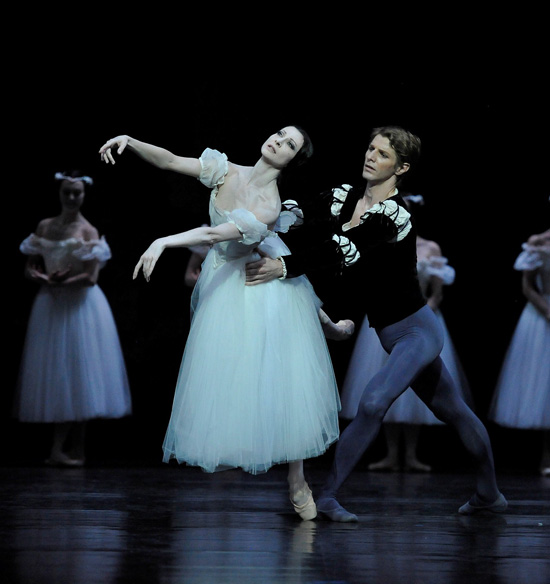Reviewed by Carlos Stafford, The Model Critic
Not having visited in almost a decade, POB is now gracing the Koch Theatre, formerly the New York State Theatre at Lincoln Center, for a few weeks this summer season with The Lincoln Center Summer Festival, 2012.
I was lucky to catch a performance of Giselle Saturday night on Bastille Day. Here are my impressions: subtlety reigned supreme in this glorious poetic offering. The company and its illustrious institutions have been with us since the beginning of the 1600’s, so all the elements of costume, set design, mime, story telling, acting prowess, and the dances themselves conveyed a refined, coherent philosophy of elegance, taste, and precision that is rarely seen in a ballet performance anywhere.
POB offers acting that is naturalistic, the mime understated, humanistic; no grand gestures that belie a disconnect between the dancer and his inner life–a reality that is easy, true and believable. Historically, that the French took mime to a high order is something you would naturally look for, as well as for the perfect rendering of costumes that blend authenticity with the necessities of movement; seen in the color and shapes of the peasant skirts, and the rich garb for the Duke, and his daughter.
The poetic manner of telling the story of Giselle is for the sagacious audience, and tends to highlight the beauty of the elements of love and forgiveness, as well as the darker shades of deception and death. The dancers seem to dance inside the story so the outer elements of dance and the technical qualities of movement are somewhat sublimated to the message at hand. The result is that the audience is coaxed into the narrative and emotional passion of the ballet instead of watching a mere dance performance. So not only is Giselle, the ballet, ethereal in its delicate and complex grave scenes with the Wilis in Act 11, but it also captures a magical suspension of disbelief. Everything suddenly grows larger and larger, and afterwards one is reminded, like Balanchine once pronounced, that ballet is women–here amended, simply and delightfully, that ballet is French–we seem to forget.
The corps was no doubt the best I’ve ever seen. Beautifully costumed, precise, fluid, and extremely musical. Their arms, head tilts, body positions, and hands all moved in one sumptuous, spectacular unit. What a group! Intelligent and aware, all seemed to be similar height and proportions adding to the illusion of oneness of spirit; the audience gasped at their blending beauty as Wilis.
The musical tempi in the overture and throughout was unapologetically slow, requiring attentiveness from the dancers. So when the orchestra played the adagio in the Grand Pas De Duex in Act 11, for example, the dancers were allowed to show a deep loving passion through their movements, unhurried by choreography, thereby inviting the audience to look and feel the gravity of Albrecht’s and Giselle’s love and ethereal connection. The dancing was not athletic necessarily, but rather soft and passionate in its artistic direction.
Details, details, details! Everywhere the finer points appealed to the adult intelligence. Some may feel that Act 1 didn’t have as much impact because of its subtle nature, and this may be true the further you sit in the auditorium. That coupled with the nature of Act 1 could make it too quiet for some–Act 1 lacking dance and mostly exposition. But the story is a gradual build to beauty and revelation, and one must be patient. Isabelle Ciarovola’s mad scene didn’t especially bring tears, but she made up for it in Act 11 as gauzy spirit. One is reminded that ballet should not be about circus and bombast only, but serves best when more complex meanings are revealed.
This Giselle was intimate, refined, and never telegraphed its intentions. It was more like a well- structured, profound poem of beauty. Albrecht, Giselle, and Myrtha, all new to me, were very connected to their characters. Hilarion was perhaps an exception, not registering genuine grief at Giselle’s death, and relying more on mime. Also, he wasn’t as angry and forbidding as a spurned lover could be, as he appeared more neutral. Giselle was young and childlike at first, then transformed into the airy, otherworldly character with great finesse. Her return to the grave at morning light, after deep forgiveness, was especially moving as Albrecht awakens from his palpable dream.
This is company that must be seen and experienced. They will perform other contemporary pieces from Maurice Bejart and Pina Bausch throughout the month.
CAST
Giselle Isabelle Ciaravola
Albrecht Karl Paquette
Hilarion Audric Bezard
Myrtha Marie-Agnes Gillot
